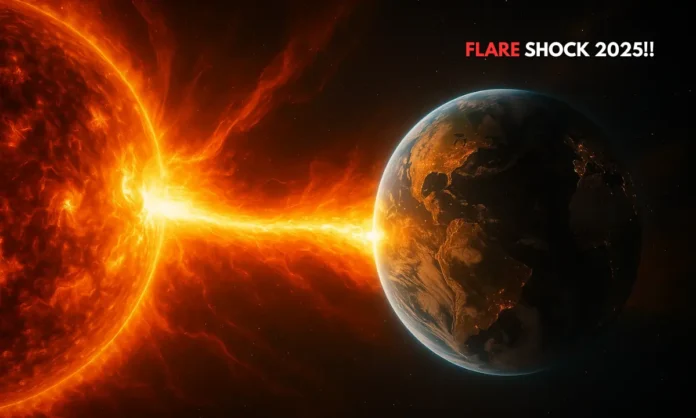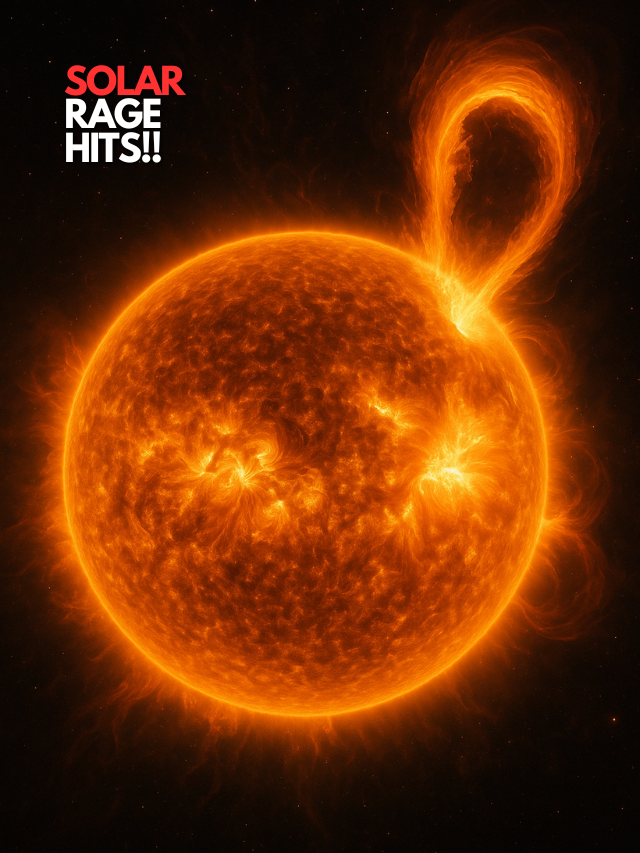Summary
- An X2.7-class solar flare triggered global shortwave radio blackouts on May 14, affecting five continents.
- Scientists warn of more flares from sunspot AR4087, with potential impacts on power grids and satellites.
- The NOAA and space agencies worldwide are on high alert as solar activity intensifies.
A Flash from the Sun, a Shock to the Earth
At 4:25 a.m. ET on May 14, the sun unleashed its strongest solar flare of 2025, disrupting life across multiple continents within seconds. This X2.7-class flare, categorized among the most powerful, triggered widespread radio blackouts and jammed high-frequency communications in North and South America, Africa, Southeast Asia, and the Middle East.
The flare, part of a solar storm wave emitted by the rapidly growing sunspot region AR4087, wasn’t just a flicker in the sky—it was a surge of solar plasma and X-ray radiation that ionised Earth’s upper atmosphere at light speed. The result: instant blackout for radio operators, aviators, and emergency responders relying on shortwave bands for critical communication.
And according to experts, this could be just the beginning.
🚨🚨🚨 MAJOR ALERT: THE SUN JUST BLASTED EARTH WITH A MASSIVE X3 SOLAR FLARE CAUSING ROLLING BLACKOUTS ALL ACROSS THE GLOBE !!! pic.twitter.com/yq2nrmqCAW
— Q ™️ (@QTHESTORMM) May 14, 2025
Blackouts, Grid Disruptions, and Satellite Danger
- The X2.7-class flare disrupted high-frequency radio across five continents.
- Hours later, AR4087 triggered additional M-class flares (M5.3 and M7.74) on May 15.
- Scientists warn of possible power grid and satellite disruptions in the coming days.
- GPS, aviation, and satellite-dependent services are vulnerable to geomagnetic fallout.
Solar flares are graded in escalating order of energy: A, B, C, M, and X. Each category represents a tenfold increase in intensity. While an X2.7 is at the lower end of the X-class spectrum, it’s still powerful enough to wreak global disruption. And it did.
The NOAA’s Space Weather Prediction Center confirmed that this flare was no ordinary burst. “Flares of this magnitude are not frequent,” its statement noted—particularly when paired with the sunspot’s strategic alignment toward Earth.
Within 24 hours of the X2.7 burst, two additional flares erupted from AR4087—first an M5.3 and then a stronger M7.74. These eruptions, though less powerful than X-class flares, still carry the potential to destabilize communication infrastructure and overload electrical grids.
If these flares are accompanied by coronal mass ejections (CMEs)—huge bubbles of solar material hurled into space—the consequences could include geomagnetic storms strong enough to damage transformers, disrupt navigation systems, and throw satellites off-course.
A Global Wake-Up Call for Space Weather Preparedness
- Vincent Ledvina, a leading aurora tracker, called the event “intense” and predicted more activity as AR4087 moves into full Earth alignment.
- NOAA has placed its monitoring systems on heightened alert through May.
- Energy utilities and aviation authorities worldwide have been advised to monitor grid activity and flight communication anomalies.
- Space agencies may issue emergency satellite repositioning protocols if CMEs are confirmed.
The visibility of this event—especially in real-time radio blackout charts and auroral activity trackers—has made it a rare wake-up call for both policymakers and the public. Despite significant technological dependence on satellites, space weather preparedness remains an underfunded and underprioritized area in many countries.
The flare’s impact also reignites debates around infrastructure resilience. Power grids in regions like Canada, Scandinavia, and parts of the U.S. Northeast are historically vulnerable to geomagnetic induced currents (GICs). During previous solar maxima, such currents led to transformer failures and long-duration blackouts.
With AR4087 expected to align fully with Earth over the next week, experts are calling for stepped-up satellite shielding, navigation recalibration, and grid protection protocols.
The Sun Isn’t Done: What’s Coming Next
- NOAA expects additional solar flare activity from AR4087 through mid-May.
- The solar cycle is approaching peak intensity (solar maximum), expected in late 2025 to early 2026.
- Governments are being advised to audit space weather policies, emergency telecom protocols, and power grid shielding.
- Scientists are exploring advanced AI models to predict CME trajectories and flare intensities.
Solar Cycle 25 is accelerating. As the sun nears its peak magnetic activity, flare frequencies and strengths are likely to increase. The sunspot group AR4087 is now at the center of this heightened phase, and as it moves into direct Earth-facing alignment, its magnetic instability poses growing risk.
NOAA and international space weather agencies are now on standby. Aviation regulators, particularly in polar routes, have begun issuing advisory notices. The space community is assessing the orbital stability of sensitive satellites. Even broadband providers are reviewing how space-based outages could ripple into ground-level internet disruptions.
In this context, the May 14 flare becomes a warning shot—not a standalone event, but a marker of what’s ahead.
When the Sky Strikes: A Future Not Yet Shielded
The strongest solar flare of 2025 may have already hit—but if AR4087 and its successors continue their streak, the disruptions of this week may only be a preview. From jamming radios to endangering satellites, solar activity is no longer an exotic anomaly—it’s a systemic risk.
Earth’s interconnected digital future now hinges not just on AI or 5G, but on our capacity to prepare for the sun’s oldest and fiercest storms. The sky, once humanity’s compass, is now its most unpredictable adversary.



